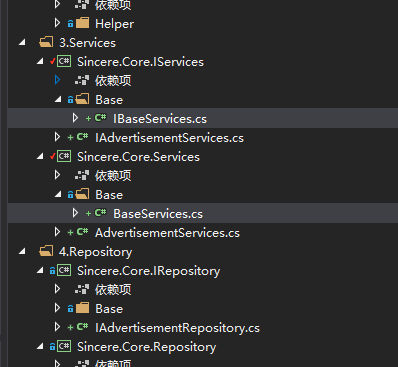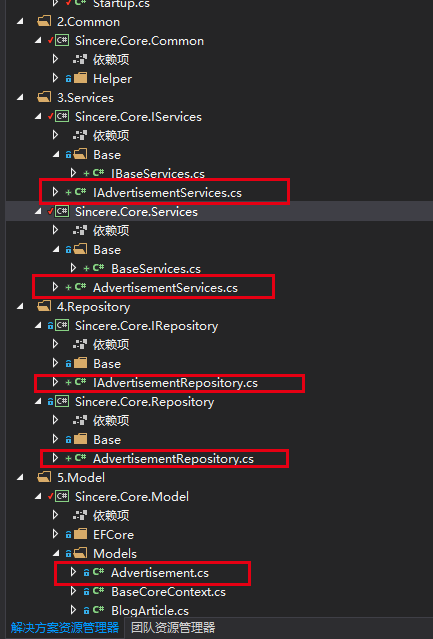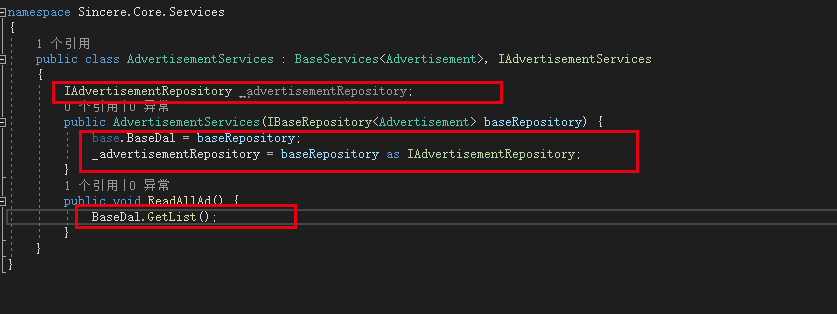.netCore+Vue 搭建的简捷开发框架 (3)-- Services层实现
继续交作业:
上一篇作业中我们实现了 Repository仓储层的应用。并为我们的框架引入了EFCore 详见:
.netCore+Vue 搭建的简捷开发框架 (2)--仓储层实现和EFCore 的使用
接下来我们继续来实现Services 层,同样,我们在Services 和IServices 中增加 Base 文件夹。并创建BaseServices.cs 和IBaseServices.cs
如图:

其中BaseServices.cs 和 IBaseServices.cs 代码如下:
using Sincere.Core.IRepository.Base;
using Sincere.Core.IServices.Base;
using Sincere.Core.Model;
using System;
using System.Collections.Generic;
using System.Data;
using System.Data.SqlClient;
using System.Linq.Expressions;
using System.Text;
using System.Threading.Tasks; namespace Sincere.Core.Services.Base
{
public class BaseServices<TEntity> : IBaseServices<TEntity> where TEntity : class, new()
{
//public IBaseRepository<TEntity> baseDal = new BaseRepository<TEntity>();
public IBaseRepository<TEntity> BaseDal;//通过在子类的构造函数中注入,这里是基类,不用构造函数 public async Task<int> Del(TEntity model)
{
return await BaseDal.Del(model);
} public async Task<int> DelBy(Expression<Func<TEntity, bool>> delWhere)
{
return await BaseDal.DelBy(delWhere);
} public async Task<int> Execute(string sql, List<SqlParameter> parms, CommandType cmdType = CommandType.Text)
{
return await BaseDal.Execute(sql,parms,cmdType);
} public async Task<List<TEntity>> GetList()
{
return await BaseDal.GetList();
} public async Task<List<TEntity>> GetListBy(Expression<Func<TEntity, bool>> whereLambda)
{
return await BaseDal.GetListBy(whereLambda);
} public async Task<List<TEntity>> GetListBy<TKey>(Expression<Func<TEntity, bool>> whereLambda, Expression<Func<TEntity, TKey>> orderLambda, bool isAsc = true)
{
return await BaseDal.GetListBy(whereLambda,orderLambda,isAsc);
} public async Task<List<TEntity>> GetListBy<TKey>(int top, Expression<Func<TEntity, bool>> whereLambda, Expression<Func<TEntity, TKey>> orderLambda, bool isAsc = true)
{
return await BaseDal.GetListBy(top, whereLambda, orderLambda, isAsc);
} public async Task<List<TEntity>> GetListBy<TKey1, TKey2>(Expression<Func<TEntity, bool>> whereLambda, Expression<Func<TEntity, TKey1>> orderLambda1, Expression<Func<TEntity, TKey2>> orderLambda2, bool isAsc1 = true, bool isAsc2 = true)
{
return await BaseDal.GetListBy( whereLambda, orderLambda1,orderLambda2, isAsc1,isAsc2);
} public async Task<List<TEntity>> GetListBy<TKey1, TKey2>(int top, Expression<Func<TEntity, bool>> whereLambda, Expression<Func<TEntity, TKey1>> orderLambda1, Expression<Func<TEntity, TKey2>> orderLambda2, bool isAsc1 = true, bool isAsc2 = true)
{
return await BaseDal.GetListBy(top, whereLambda, orderLambda1, orderLambda2, isAsc1, isAsc2);
} public async Task<TEntity> GetModelById(Expression<Func<TEntity, bool>> whereLambda)
{
return await BaseDal.GetModelById( whereLambda);
} public async Task<List<TEntity>> GetPagedList<TKey>(int pageIndex, int pageSize, Expression<Func<TEntity, bool>> whereLambda, Expression<Func<TEntity, TKey>> orderByLambda, bool isAsc = true)
{
return await BaseDal.GetPagedList(pageIndex,pageSize, whereLambda,orderByLambda,isAsc);
} public async Task<PageModel<TEntity>> GetPagedList<TKey>(Expression<Func<TEntity, bool>> whereLambda, Expression<Func<TEntity, TKey>> orderByLambda, bool isAsc = true, int pageIndex = , int pageSize = )
{
return await BaseDal.GetPagedList( whereLambda, orderByLambda, isAsc, pageIndex, pageSize);
} public async Task<bool> Insert(TEntity model)
{
return await BaseDal.Insert(model);
} public async Task<bool> InsertRange(List<TEntity> datas)
{
return await BaseDal.InsertRange(datas);
} public async Task<int> Modify(TEntity model)
{
return await BaseDal.Modify(model);
} public async Task<int> Modify(TEntity model, params string[] propertyNames)
{
return await BaseDal.Modify(model,propertyNames);
} public async Task<int> ModifyBy(TEntity model, Expression<Func<TEntity, bool>> whereLambda, params string[] modifiedPropertyNames)
{
return await BaseDal.ModifyBy(model, whereLambda,modifiedPropertyNames);
} public async Task<List<TEntity>> Query(string sql, List<SqlParameter> parms, CommandType cmdType = CommandType.Text)
{
return await BaseDal.Query(sql, parms, cmdType);
} public void RollBackChanges()
{
BaseDal.RollBackChanges();
}
} }
BaseServices
using Sincere.Core.Model;
using System;
using System.Collections.Generic;
using System.Data;
using System.Data.SqlClient;
using System.Linq.Expressions;
using System.Text;
using System.Threading.Tasks; namespace Sincere.Core.IServices.Base
{
public interface IBaseServices<TEntity> where TEntity : class
{
Task<int> Execute(string sql, List<SqlParameter> parms, CommandType cmdType = CommandType.Text);
Task<List<TEntity>> Query(string sql, List<SqlParameter> parms, CommandType cmdType = CommandType.Text);
Task<bool> Insert(TEntity model);
Task<bool> InsertRange(List<TEntity> datas); Task<int> Del(TEntity model); Task<int> DelBy(Expression<Func<TEntity, bool>> delWhere); Task<int> Modify(TEntity model); Task<int> Modify(TEntity model, params string[] propertyNames); Task<int> ModifyBy(TEntity model, Expression<Func<TEntity, bool>> whereLambda, params string[] modifiedPropertyNames); Task<List<TEntity>> GetList(); Task<List<TEntity>> GetListBy(Expression<Func<TEntity, bool>> whereLambda); Task<TEntity> GetModelById(Expression<Func<TEntity, bool>> whereLambda); Task<List<TEntity>> GetListBy<TKey>(Expression<Func<TEntity, bool>> whereLambda, Expression<Func<TEntity, TKey>> orderLambda, bool isAsc = true); Task<List<TEntity>> GetListBy<TKey>(int top, Expression<Func<TEntity, bool>> whereLambda, Expression<Func<TEntity, TKey>> orderLambda, bool isAsc = true); Task<List<TEntity>> GetListBy<TKey1, TKey2>(Expression<Func<TEntity, bool>> whereLambda, Expression<Func<TEntity, TKey1>> orderLambda1, Expression<Func<TEntity, TKey2>> orderLambda2, bool isAsc1 = true, bool isAsc2 = true); Task<List<TEntity>> GetListBy<TKey1, TKey2>(int top, Expression<Func<TEntity, bool>> whereLambda, Expression<Func<TEntity, TKey1>> orderLambda1, Expression<Func<TEntity, TKey2>> orderLambda2, bool isAsc1 = true, bool isAsc2 = true); Task<List<TEntity>> GetPagedList<TKey>(int pageIndex, int pageSize, Expression<Func<TEntity, bool>> whereLambda, Expression<Func<TEntity, TKey>> orderByLambda, bool isAsc = true); Task<PageModel<TEntity>> GetPagedList<TKey>(Expression<Func<TEntity, bool>> whereLambda, Expression<Func<TEntity, TKey>> orderByLambda, bool isAsc = true, int pageIndex = , int pageSize = ); void RollBackChanges();
} }
IBaseServices.cs
需要说明的是,在BaseServices.cs 中我们通过依赖注入的方式引入了IBaseRepository 。

具体的引用需要在子类的构造函数中注入。
结合上一篇中的内容,我们现在的框架就已经搭建好了最基础的框架模型中的Services 和 Repository 层。
为了验证各层之间的调用。接下来我们依旧参照 张老师的课程中使用的Advertisement 类,来进行测试。
我们需要依次建立 Advertisement.cs (Model,已经在上一节中建好) 、IAdvertisementRepository(IRepository 中),AdvertisementRepository(Repository 中)、IAdvertisementServices(IServices中)、AdvertisementServices(Services中)
建好后的代码结构如下:

以后我们在此框架上开发其他服务的时候,也参照这样的目录结构建立相应文件。
接下来依次介绍各个文件,以及其实现过程。
首先是IAdvertisementRepository.cs
这个没什么好说的,继承自 IBaseRepository<Advertisement>。这里面我没有写其他的业务逻辑,是一个空的接口。代码如下:
using Sincere.Core.IRepository.Base;
using Sincere.Core.Model.Models;
using System;
using System.Collections.Generic;
using System.Text; namespace Sincere.Core.IRepository
{
public interface IAdvertisementRepository : IBaseRepository<Advertisement>
{ }
}
接下来是AdvertisementRepository.cs ,这里继承自BaseRepository<Advertisement>, 并实现 IAdvertisementRepository接口。代码如下:
using Sincere.Core.IRepository;
using Sincere.Core.Model.EFCore;
using Sincere.Core.Model.Models;
using Sincere.Core.Repository.Base;
using System;
using System.Collections.Generic;
using System.Text; namespace Sincere.Core.Repository
{
public class AdvertisementRepository : BaseRepository<Advertisement>, IAdvertisementRepository
{
public AdvertisementRepository(IBaseContext mydbcontext) : base(mydbcontext)
{ }
}
}
这里需要说明的是,因为我在BaseRepository 的构造函数中,使用了有参数的构造函数
public BaseRepository(IBaseContext mydbcontext)
{
this._db = mydbcontext as BaseCoreContext;
this._dbSet = _db.Set<TEntity>();
}
所以在AdvertisementRepository 中,将注入的mydbContext 同步注入到BaseRepository 中。

仓储层的逻辑基本就这样了,接下来写Services中的实现。
同样,首先是接口IAdvertisementServices,继承IBaseServices<Advertisement>。没什么好说的,这里为了假装有一个方法,叫做ReadAllAd(),代码如下:
using Sincere.Core.IServices.Base;
using Sincere.Core.Model.Models;
using System;
using System.Collections.Generic;
using System.Text; namespace Sincere.Core.IServices
{
public interface IAdvertisementServices : IBaseServices<Advertisement>
{
void ReadAllAd();
}
}
最后就是AdvertisementServices了,未来的开发中,我们大部分的业务逻辑都将在这里实现,于仓储层的实现类似,也是继承: BaseServices<Advertisement>, 实现 IAdvertisementServices接口。
代码如下:
using Sincere.Core.IRepository;
using Sincere.Core.IRepository.Base;
using Sincere.Core.IServices;
using Sincere.Core.Model.Models;
using Sincere.Core.Services.Base;
using System;
using System.Collections.Generic;
using System.Text; namespace Sincere.Core.Services
{
public class AdvertisementServices : BaseServices<Advertisement>, IAdvertisementServices
{
IAdvertisementRepository _advertisementRepository;
public AdvertisementServices(IBaseRepository<Advertisement> baseRepository) {
base.BaseDal = baseRepository;
_advertisementRepository = baseRepository as IAdvertisementRepository;
}
public void ReadAllAd() { }
}
}
这里有些地方需要进行一下说明。首先就是通过依赖注入的方式,将IBaseRepository 注入进来。

在ReadAllAd 方法中的引用如上图所示。
到此为止,各个层中的实现就都完成了。但是我们在Controller 中该怎么引用呢?
这个地方涉及的东西比较多,比如NetCore 的依赖注入、利用反射机制进行注入、NetCore 的Startup.cs 类等内容。准备用下一节的内容来进行整体说明。谢谢。
谢谢。
.netCore+Vue 搭建的简捷开发框架 (3)-- Services层实现的更多相关文章
- .netCore+Vue 搭建的简捷开发框架 (5)
文章目录:.netCore+Vue 搭建的简捷开发框架--目录 上两节的内容介绍了一些关于.netCore 相关的一些基础知识.介绍这些的目的,最主要的还是为了我们的架构搭建服务. 上一节中,我们介绍 ...
- .netCore+Vue 搭建的简捷开发框架--目录
.netCore+Vue 搭建的简捷开发框架 .netCore+Vue 搭建的简捷开发框架 (2)--仓储层实现和EFCore 的使用 .netCore+Vue 搭建的简捷开发框架 (3)-- Ser ...
- .netCore+Vue 搭建的简捷开发框架
话不多说,上图: 整体项目结构如图所示,我的设计初衷是基于.netCore + DI + Vue 打造一个适合初学者的简捷开发框架. 架构模型采用基于RESTful API风格的前后台分离框架,总体分 ...
- .netCore+Vue 搭建的简捷开发框架 (4)--NetCore 基础
书接上文:上一节中,我们已经实现Services 层.(https://www.cnblogs.com/xuzhencheng/p/11424751.html) 但是具体要如何将服务依赖注入进来呢?继 ...
- .netCore+Vue 搭建的简捷开发框架 (2)--仓储层实现和EFCore 的使用
书接上文,继续搭建我们基于.netCore 的开发框架.首先是我们的项目分层结构. 这个分层结构,是参考张老师的分层结构,但是实际项目中,我没有去实现仓储模型.因为我使用的是EFCore ,最近也一直 ...
- .netCore+Vue 搭建的简捷开发框架 (4)--NetCore 基础 -2
上节中,我们初步的介绍了一下NetCore的一些基础知识,为了控制篇幅(其实也是因为偷懒),我将NetCore 基础分为两部分来写. 0.WebAPI 项目的建立 1..NetCore 项目执行(加载 ...
- .netcore+vue+elementUI 前后端分离---支持前端、后台业务代码扩展的快速开发框架
框架采用.NetCore + Vue前后端分离,并且支持前端.后台代码业务动态扩展,框架内置了一套有着20多种属性配置的代码生成器,可灵活配置生成的代码,代码生成器界面配置完成即可生成单表(主表)的增 ...
- Linux+.NetCore+Nginx搭建集群
本篇和大家分享的是Linux+NetCore+Nginx搭建负载集群,对于netcore2.0发布后,我一直在看官网的文档并学习,关注有哪些新增的东西,我,一个从1.0到2.0的跟随者这里只总结一句话 ...
- 01 基于umi搭建React快速开发框架
介绍 基于umi搭建一个快速开发框架,react 应用框架.umi 以路由为基础的,支持类 next.js 的约定式路由,以及各种进阶的路由功能,并以此进行功能扩展,比如支持路由级的按需加载. 我们会 ...
随机推荐
- 给定n个十六进制正整数,输出它们对应的八进制数。
问题描述 给定n个十六进制正整数,输出它们对应的八进制数. 输入格式 输入的第一行为一个正整数n (1<=n<=10). 接下来n行,每行一个由0~9.大写字母A~F组成的字符串,表示要转 ...
- 基于开源中文分词工具pkuseg-python,我用张小龙的3万字演讲做了测试
做过搜索的同学都知道,分词的好坏直接决定了搜索的质量,在英文中分词比中文要简单,因为英文是一个个单词通过空格来划分每个词的,而中文都一个个句子,单独一个汉字没有任何意义,必须联系前后文字才能正确表达它 ...
- TomatoLog-1.1.0实现ILoggerFactory
TomatoLog TomatoLog 是一个基于 .NETCore 平台的产品. The TomatoLog 是一个中间件,包含客户端.服务端,非常容易使用和部署. 客户端实现了ILoggerFac ...
- 跟我学SpringCloud | 第十六篇:微服务利剑之APM平台(二)Pinpoint
目录 SpringCloud系列教程 | 第十六篇:微服务利剑之APM平台(二)Pinpoint 1. Pinpoint概述 2. Pinpoint主要特性 3. Pinpoint优势 4. Pinp ...
- Codeforces 1008C
题意略. 思路: 其实我们没有必要关注每个数字的位置,我们只要把大的数字放在小的数字上就可以了,这样它的位置必然会发生变换. 在变换时,这个替换的序列越长越好,每个序列对答案的贡献就是该序列的长度 - ...
- Git 忽略某些文件提交
在项目中有些配置文件不需要提交,但是有同学在后面开发中发现在.igonore文件中无论如何都无法忽略某些文件的提交.原因在这里: 已经维护起来的文件,即使加上了gitignore,也无济于事.---- ...
- npm基本命令
1.npm是什么? npm(Node Package Manager)意思是 node 的包管理器,它是随着 NodeJs 安装时一起被安装的: 无论是在前端还是在前端开发中都会使用到 npm 包管理 ...
- P3980 [NOI2008]志愿者招募 费用流 (人有多大胆地有多大产
https://www.luogu.org/problemnew/show/P3980 感觉费用流比网络流的图更难想到,要更大胆.首先由于日期是连续的,所以图中的点是横向排列的. 这道题有点绕道走的意 ...
- 洛谷P1372 又是毕业季I+数学
P1372 又是毕业季I 题意:在1-n中找到k个数,使得这k个数的最大公因数最大: 思路,题解: 因为两个数成倍数关系时,它们的最大公因数是两数中的较小数,也就是相对来说最大公因数较大 返回题目,这 ...
- 模板汇总——LCT
link-cut tree #define lch(x) tr[x].son[0] #define rch(x) tr[x].son[1] ; struct Node{ int rev, rt; ], ...
